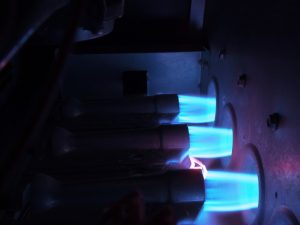 If we had to take a guess at the type of heater you have to warm your home during our typically long and chilly winters, we’d probably be safe in assuming you use a natural gas furnace. After all, these are the most popular heaters throughout the country, and their popularity is highest in states with climates like ours. Natural gas is a cost-effective fuel source—much more so than electricity. Because most homes also have ductwork running through them, furnaces are also more popular than boilers in general.
If we had to take a guess at the type of heater you have to warm your home during our typically long and chilly winters, we’d probably be safe in assuming you use a natural gas furnace. After all, these are the most popular heaters throughout the country, and their popularity is highest in states with climates like ours. Natural gas is a cost-effective fuel source—much more so than electricity. Because most homes also have ductwork running through them, furnaces are also more popular than boilers in general.
Furnaces today are built to the highest safety standards, and will operate even safer if you keep up on yearly maintenance appointments. But even the best and most well-cared for gas furnace has the potential for gas leaks and combustion hazards that require prompt Glenview, IL furnace repair. With a gas furnace, the biggest repair concern a cracked heat exchanger. Ignoring a damaged heat exchanger can lead to a huge safety hazard.
First, What’s a Heat Exchanger?
Of course, we can’t expect you to take a cracked heat exchanger hazard seriously if you don’t even know what a heat exchanger is. Essentially, it’s the component within your gas furnace that applies heat to the air that the blower fan sends through your ventilation system. It’s a metal chamber (or, a series of metal chambers) shaped like a clam shell, where the hot combustion gas from the burner collects.
The intense heat of the gas raises the temperature of the metal walls, making the outside of the heat exchanger very hot. Air form the blower flows around the heat exchanger and picks up heat form it. This allows the furnace to actually apply the heat of the combustion gas without letting the gasses contact the air that enters your home.
How Do Heat Exchangers Crack?
The heat exchangers within a furnace undergo a great deal of stress. Each time one heats up, the metal expands. Over the years, the constant expansion and contraction can weaken the metal, eventually causing corrosion. This is particularly true if the gas isn’t well vented out of the flue. Corrosion weakens metal, causing small fissures, or cracks, along the heat exchanger.
The Danger of a Cracked Heat Exchanger
Cracks along a heat exchanger may look harmless—small and insignificant. In fact, you could pour water into a cracked heat exchanger and not a drop would leak through. However, these cracks widen when the heat exchanger expands, from the intense heat, and this lets the unhealthy gases that are supposed to be vented into the flue instead go right into the air traveling to the living spaces. CO leaks leading to illness within homes are often traced back to cracked heat exchangers!
It’s important that you keep up with heating maintenance for any furnace, but this is particularly the case for furnaces 15+ years old. Aging furnaces are more susceptible to problems, including cracked heat exchangers. If your system is approaching this age or older, then it’s definitely time to give our pros a call to see if it’s time for an upgrade.
To keep your heater working safe and effectively, trust Shavitz Heating and Air Conditioning for your furnace services.


